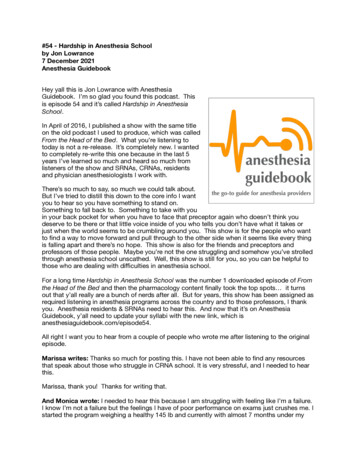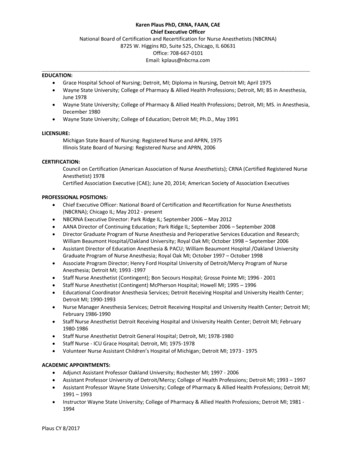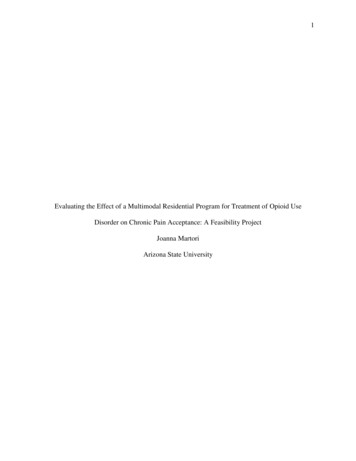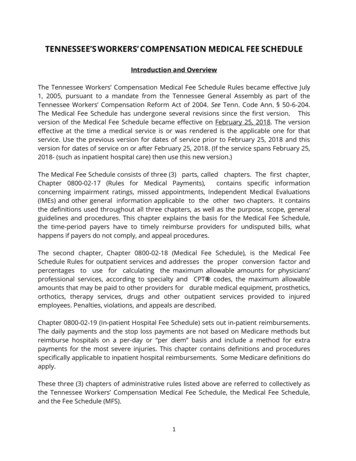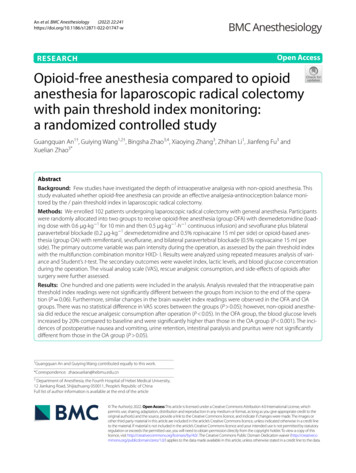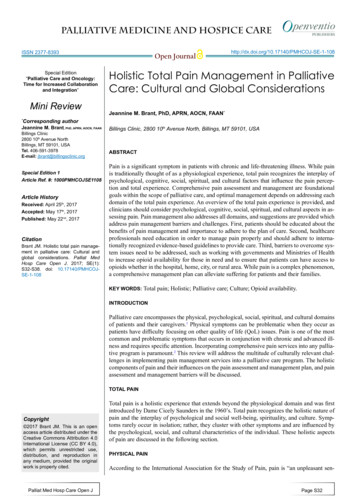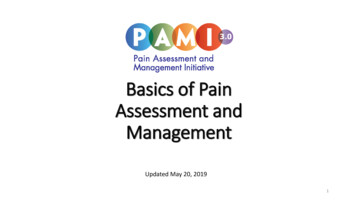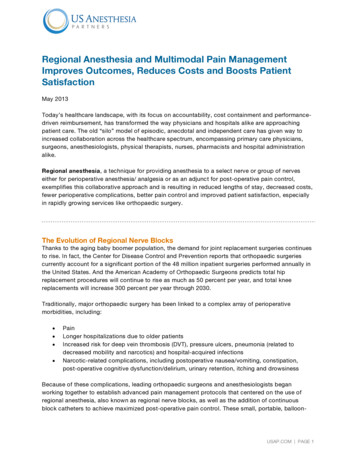
Transcription
Regional Anesthesia and Multimodal Pain ManagementImproves Outcomes, Reduces Costs and Boosts PatientSatisfactionMay 2013Today’s healthcare landscape, with its focus on accountability, cost containment and performancedriven reimbursement, has transformed the way physicians and hospitals alike are approachingpatient care. The old “silo” model of episodic, anecdotal and independent care has given way toincreased collaboration across the healthcare spectrum, encompassing primary care physicians,surgeons, anesthesiologists, physical therapists, nurses, pharmacists and hospital administrationalike.Regional anesthesia, a technique for providing anesthesia to a select nerve or group of nerveseither for perioperative anesthesia/ analgesia or as an adjunct for post-operative pain control,exemplifies this collaborative approach and is resulting in reduced lengths of stay, decreased costs,fewer perioperative complications, better pain control and improved patient satisfaction, especiallyin rapidly growing services like orthopaedic surgery.The Evolution of Regional Nerve BlocksThanks to the aging baby boomer population, the demand for joint replacement surgeries continuesto rise. In fact, the Center for Disease Control and Prevention reports that orthopaedic surgeriescurrently account for a significant portion of the 48 million inpatient surgeries performed annually inthe United States. And the American Academy of Orthopaedic Surgeons predicts total hipreplacement procedures will continue to rise as much as 50 percent per year, and total kneereplacements will increase 300 percent per year through 2030.Traditionally, major orthopaedic surgery has been linked to a complex array of perioperativemorbidities, including: PainLonger hospitalizations due to older patientsIncreased risk for deep vein thrombosis (DVT), pressure ulcers, pneumonia (related todecreased mobility and narcotics) and hospital-acquired infectionsNarcotic-related complications, including postoperative nausea/vomiting, constipation,post-operative cognitive dysfunction/delirium, urinary retention, itching and drowsinessBecause of these complications, leading orthopaedic surgeons and anesthesiologists beganworking together to establish advanced pain management protocols that centered on the use ofregional anesthesia, also known as regional nerve blocks, as well as the addition of continuousblock catheters to achieve maximized post-operative pain control. These small, portable, balloon-USAP.COM PAGE 1
type pumps deliver local anesthetic directly to a patient’s surgical site over the course of severaldays.What started with single-injection nerve blocks for outpatient orthopaedic surgery has evolved intocomprehensive, multimodal analgesic regional nerve block programs.Historical Evolution of Regional AnesthesiaRegional Anesthesia Revolutionizes Patient CareThe clinical benefits of regional nerve blocks have been closely studied and clearly documented1: Shorter hospital stays2,3,4 and as a result, increased throughputReduced PACU 5,6 stayso The number #1 and #2 reasons for an extended PACU stay are pain and postoperative nausea/vomitingSignificantly lower pain scores and better HCAPHS scoresReduced post-op cognitive dysfunction/deliriumo Elderly patients experience up to a 58% decrease in dysfunction/delirium withregional anesthesia compared to use of narcotics.Patients also experience fewer complications, including DVT, surgical site infections, catheterrelated urinary tract infections, pneumonia, pressure ulcers, constipation/ileus, nausea/vomiting andpostoperative respiratory depression.In addition, one of the biggest game changers for orthopaedic surgery is the ability to start earlierrehabilitation. This is resulting in significantly improved surgical outcomes, including increasedrange of motion, gait and balance. In a study of total knee arthroplasty (TKA) patients, regionalnerve blocks resulted in 7: Initiation of therapy within 24 hrs of surgery (vs. 48 and 72 hours for the control group)Shorter hospital staysFewer inpatient rehab sessions overallUSAP.COM PAGE 2
Less painGreater range of motion in flexion and extensionImproved strength in quads and hamstringsHigher scores on assessments of gait and balanceThe Economic BenefitsInpatient Care SavingsBeyond the clinical benefits, regional anesthesia programs positively impact the bottom line. Two ofthe most common surgical procedures performed in the U.S., total knee and hip arthroplasty,account for the single greatest Medicare procedural expenditure. A landmark study from the MayoClinic demonstrated the implementation of a total joint regional anesthesia program significantlyreduced estimated mean direct hospital costs by an average of 1,999 per case whencompared with controls:8 Increased savings in ASA 3/4 patientsA significant reduction in hospital-based (Medicare Part A costs) accounted for the majorityof the total cost savings.Cost savings with regional anesthesia are typically achieved through better patient outcomes andfewer interventions, and the resulting lower overall medical supply costs as well as a significantreduction in hospital length of stay. These savings are found in a number of ways: 1.2 day length of stay (LOS) reduction (average hospital’s cost per day for a surgical patient 1,6579)Lower opioid usage and as a result, lower opioid-related adverse effectsFewer medical interventions, resulting in lower medical supply costs (urinary catheters, NGtubes, fluids, medications, lab draws)Reduced PACU stays8Duncan, CM, Hall Long, K, Warner, DO, Hebl, JR. “The Economic Implications of a MultimodalAnalgesic Regimen for Patients Undergoing Major Orthopedic Surgery - A Comparative Study ofDirect Costs.” Regional Anesthesia and Pain Medicine. July 2009.USAP.COM PAGE 3
Outpatient Care SavingsSAVINGS with Regional Anesthesia 1.2 millionChart represents an annual caseload of 3,000. Based on median hospital cost of 3,500 per patient. Regional anesthesia patients received no volatile anesthetics.Additional Benefits: Achieving Market LeadershipNot only is patient satisfaction critical to healthcare reform initiatives and reimbursement, it is a truedifferentiator and can lead to significant competitive advantage in the local marketplace. And one ofthe key benefits of regional anesthesia programs -- pain control -- plays one of the most powerfulroles in achieving strong patient satisfaction scores.The Centers for Medicare and Medicaid Services’ (CMS) Hospital Consumer Assessment ofHealthcare Providers and Systems (HCAHPS) survey has emerged as the gold standard formeasuring patient satisfaction and asks patients specific questions related to the quality of theirpain management during their hospital stay. Questions include: During this hospital stay, how often was your pain well controlled?During this hospital stay, how often did the hospital staff do everything they could tohelp you with your pain?Would you recommend this hospital to your friends and family?Healthcare systems throughout the country are finding that regional anesthesia protocols positivelyimpact their HCAHPS scores10,11,12. In fact, according to Healthgrades, a leading online resource forinformation about physicians and hospitals, hospitals with the top 15 percent of HCAHPS scoreshad 26 percent more patients reporting pain well controlled than the bottom 15 percent.USAP.COM PAGE 4
In addition to improved post-surgical pain management and patient satisfaction, regional anesthesiaalso increases the number of surgeries that can be performed due to improved throughput andincreased capacity as well as facilitating inpatient cases to outpatient.Creating ValueIt has been said that the problem hospitals face today is not so much one of costs but one of value.And value encompasses outcomes as well as costs.9 Regional anesthesia programs and theimproved patient outcomes, satisfaction and cost savings they bring add value and presenthospitals with an opportunity to stay ahead of the curve and position themselves as true marketleaders in the new healthcare economy.About U.S. Anesthesia PartnersU.S. Anesthesia Partners is a single-specialty physician services organization that offers practicemanagement to anesthesiologists. It was formed by JLR Medical Group and other leadinganesthesia practices to create a platform with the capital resources and expertise to invest in theirpractice support infrastructure and position them for continued success and growth within theirmarkets. Key elements of USAP’s business model are its single-specialty focus and its ability tooffer anesthesiologists equity ownership in USAP. USAP and its affiliates have more than 1,200anesthesia providers serving three major metropolitan markets. USAP is sponsored by Welsh,Carson, Anderson & Stowe, an investment firm with significant experience investing in and buildingleading healthcare companies. Please visit www.usap.com to learn more.USAP.COM PAGE 5
References1. Jankowski CJ, Trenerry MR, Cook DJ, Buenvenida SL, Stevens SR, Schroeder DR, WarnerDO. “Cognitive and Functional Predictors and Sequelae of Postoperative Elirium in ElderlyPatients Undergoing Elective Joint Arthroplasty.“ Anesthesia and Analgesia. 2011May;112(5):1186-93. doi: 10.1213/ANE.0b013e318211501b. Epub 2011 Mar 17.2. Hunt, KJ et al. “Continuous Peripheral Nerve Blockade as Postoperative Analgesia for OpenTreatment of Calcaneal Fractures.” Journal of Orthopaedic Trauma. 20103. Gomez-Cardero P & Rodriguez-Merchan EC. “Postoperative analgesia in TKA: RopivacaineContinuous Intraarticular Infusion.” Clinical Orthopaedics and Related Research. 20104. Boughey, JC et al. “Improved Postoperative Pain Control using Thoracic Paravertebral Blockfor Breast Operations.” Breast Journal. 2009.5. Akcaboy, EY, Akcaboy ZN, Gogus. “Comparison of Paravertebral Block versus Fast-trackGeneral Anesthesia in Outpatient Inguinal Herniorrhaphy.” Journal of Anesthesia. 2010.6. Yauger YJ et al. “Patient Outcomes Comparing CRNA-administered Peripheral Nerve Blocksand General Anesthetics ” American Association of Nurse Anesthetists Journal. 2010.7. Labraca NS, Castro-Sánchez AM, Matarán-Peñarrocha GA, Arroyo-Morales M, SánchezJoya Mdel M, Moreno-Lorenzo C. “Benefits of Starting Rehabilitation within 24 Hours ofPrimary Total Knee Arthroplasty: Randomized Clinical Trial. Clinical Rehabilitation. 2011Jun;25(6):557-66. doi: 10.1177/0269215510393759. Epub 2011 Mar 7.8. Duncan, CM, Hall Long, K, Warner, DO, Hebl, JR. “The Economic Implications of aMultimodal Analgesic Regimen for Patients Undergoing Major Orthopedic Surgery - AComparative Study of Direct Costs.” Regional Anesthesia and Pain Medicine. July 2009.9. Whelan, C. “The New Economic of Healthcare: Evaluating Medical Technologies Based onActual Value as a Growth Strategy for Healthcare Providers.” Frost & Sullivan Economics ofHealthcare. 2010.10. Jansen, TK et al. “Will the Addition of a Sciatic Nerve Block to a Femoral Nerve BlockProvide Better Pain Control ?” American Association of Nurse Anesthetists Journal. 2009.11. Marino et al. “Continuous Lumbar Plexus Block for Postoperative Pain Control After TotalHip Arthroplasty ” The Journal of Bone and Joint Sugery. 2009.12. Gallay, SH et al. “Development of a Regional Model of Care for Ambulatory Total ShoulderArthroplasty ” Clinical Orthopaedics and Related Research. 2008.13. Williams BA, Motolenich P, Kentor ML. “Hospital Facilities and Resource Management:Economic Impact of a High-Volume Regional Anesthesia Program for Outpatients.”International Anesthesiology Clinics. 2005 Summer; 43(3):43-51.USAP.COM PAGE 6
Because of these complications, leading orthopaedic surgeons and anesthesiologists began working together to establish advanced pain management protocols that centered on the use of regional anesthesia, also known as regional nerve blocks, as well as the addition of continuous block catheters to achieve maximized post-operative pain control.



